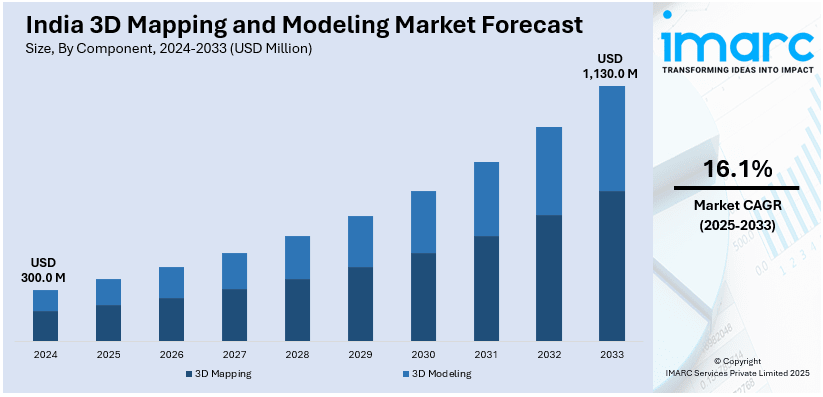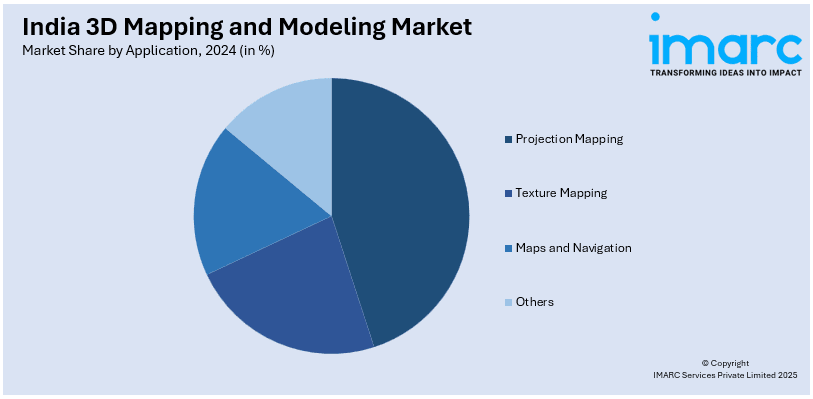
India 3D Mapping and Modeling Market Size, Share, Trends, and Forecast by Component, Application, End Use Industry, and Region, 2025-2033
India 3D Mapping and Modeling Market Overview:
The India 3D mapping and modeling market size reached USD 300.0 Million in 2024. Looking forward, IMARC Group expects the market to reach USD 1,130.0 Million by 2033, exhibiting a growth rate (CAGR) of 16.1% during 2025-2033. The market is expanding due to the rising demand in construction, urban planning, and geospatial applications. Growth is further driven by advancements in AI, LiDAR, and drone-based mapping, with increasing adoption in defense, gaming, and smart city development.
|
Report Attribute
|
Key Statistics
|
|---|---|
|
Base Year
|
2024 |
|
Forecast Years
|
2025-2033
|
|
Historical Years
|
2019-2024
|
| Market Size in 2024 | USD 300.0 Million |
| Market Forecast in 2033 | USD 1,130.0 Million |
| Market Growth Rate 2025-2033 | 16.1% |
India 3D Mapping and Modeling Market Trends:
Rising Adoption of AI and LiDAR in 3D Mapping
The incorporation of both Light Detection and Ranging (LiDAR) and artificial intelligence (AI) technology is transforming the India 3D mapping and modeling market. AI-powered automation significantly improves data processing, facilitating quicker and more precise 3D model generation. LiDAR technology, comprehensively leveraged for urban planning, infrastructure development, and smart city ventures, offers elevated-precision spatial data. Government projects incentivize private sector participation, further accelerating adoption. For instance, as per the Press Information Bureau, the Government of India launched its 2025-2026 union budget that fortified nation's aim to the geospatial segment by allocating USD 120 Million for the National Geospatial Mission. This initiative targets to develop foundational geospatial data and infrastructure, exhibiting a critical role in modernization of land records, infrastructure development, and urban planning. The use of LiDAR-based 3D mapping allows for design accuracy and project visualization in sectors like real estate. The rising demand for AI-engineered geospatial solutions in defense and disaster management for terrain analysis and simulation is also on the increase. Companies are investing in AI-powered software to streamline workflows and improve efficiency in 3D model creation. As urbanization and digital twin adoption grow, AI and LiDAR-driven mapping solutions are expected to play a critical role in India’s infrastructure and technology ecosystem.

To get more information on this market, Request Sample
Expanding Applications in Smart Cities and Infrastructure Development
The magnifying emphasis on smart cities and large-scale infrastructure ventures is a major driver of India 3D mapping and modeling market. Government-led initiatives such as the Smart Cities Mission and Gati Shakti are creating demand for high-resolution 3D geospatial data to support efficient urban planning and infrastructure management. For instance, as per industry reports, under the Gati Shakti Scheme, 208 major infrastructure projects worth USD 185.4 Billion have been evaluated, aligning with its principles. Additionally, 434 projects have been implemented across three railway economic corridors. In line with this, infrastructure investment across India is expected to rise to 6.5% of GDP by 2029, up from 5.3% in FY2024. Furthermore, 3D mapping technologies are extensively used in road network optimization, traffic management, and underground utility mapping, ensuring better planning and resource allocation. In construction, Building Information Modeling (BIM) integrates 3D modeling to improve project efficiency, minimize errors, and enhance sustainability. The adoption of 3D mapping in sectors like railways, airports, and metro projects is also increasing, improving operational planning and safety assessments. With continued infrastructure expansion and digital transformation, 3D mapping solutions are becoming essential tools for public and private sector entities, driving innovation and efficiency in India’s rapidly growing urban landscape.
India 3D Mapping and Modeling Market Segmentation:
IMARC Group provides an analysis of the key trends in each segment of the market, along with forecasts at the region level for 2025-2033. Our report has categorized the market based on component, application, and end use industry.
Component Insights:
- 3D Mapping
- 3D Modeling
The report has provided a detailed breakup and analysis of the market based on the component. This includes 3D mapping and 3D modeling.
Application Insights:

- Projection Mapping
- Texture Mapping
- Maps and Navigation
- Others
A detailed breakup and analysis of the market based on the application have also been provided in the report. This includes projection mapping, texture mapping, maps and navigation, and others.
End Use Industry Insights:
- Construction Industry
- Transportation Industry
- Automobile Industry
- Entertainment Industry
- Healthcare Industry
- Others
A detailed breakup and analysis of the market based on the end use industry have also been provided in the report. This includes construction industry, transportation industry, automobile industry, entertainment industry, healthcare industry, and others.
Regional Insights:
- North India
- South India
- East India
- West India
The report has also provided a comprehensive analysis of all the major regional markets, which include North India, South India, East India, and West India.
Competitive Landscape:
The market research report has also provided a comprehensive analysis of the competitive landscape. Competitive analysis such as market structure, key player positioning, top winning strategies, competitive dashboard, and company evaluation quadrant has been covered in the report. Also, detailed profiles of all major companies have been provided.
India 3D Mapping and Modeling Market News:
- In March 2025, Genesys International Corporation Ltd. announced signing a contract worth USD 2.58 Million with Hubballi-Dharwad Municipal Corporation to deploy Digital Twin Technology. This initiative targets to enhance infrastructure management by leveraging cutting-edge geospatial mapping.
- In March 2024, the government of Hong Kong announced collaboration with Avineon India Pvt. Ltd., a geospatial company, to boost smart city development by launching its 3D digital mapping venture.
India 3D Mapping and Modeling Market Report Coverage:
| Report Features | Details |
|---|---|
| Base Year of the Analysis | 2024 |
| Historical Period | 2019-2024 |
| Forecast Period | 2025-2033 |
| Units | Million USD |
| Scope of the Report | Exploration of Historical Trends and Market Outlook, Industry Catalysts and Challenges, Segment-Wise Historical and Future Market Assessment:
|
| Components Covered | 3D Mapping, 3D Modeling |
| Applications Covered | Projection Mapping, Texture Mapping, Maps and Navigation, Others |
| End Use Industries Covered | Construction Industry, Transportation Industry, Automobile Industry, Entertainment Industry, Healthcare Industry, Others |
| Regions Covered | North India, South India, East India, West India |
| Customization Scope | 10% Free Customization |
| Post-Sale Analyst Support | 10-12 Weeks |
| Delivery Format | PDF and Excel through Email (We can also provide the editable version of the report in PPT/Word format on special request) |
Key Questions Answered in This Report:
- How has the India 3D mapping and modeling market performed so far and how will it perform in the coming years?
- What is the breakup of the India 3D mapping and modeling market on the basis of component?
- What is the breakup of the India 3D mapping and modeling market on the basis of application?
- What is the breakup of the India 3D mapping and modeling market on the basis of end use industry?
- What is the breakup of the India 3D mapping and modeling market on the basis of region?
- What are the various stages in the value chain of the India 3D mapping and modeling market?
- What are the key driving factors and challenges in the India 3D mapping and modeling market?
- What is the structure of the India 3D mapping and modeling market and who are the key players?
- What is the degree of competition in the India 3D mapping and modeling market?
Key Benefits for Stakeholders:
- IMARC’s industry report offers a comprehensive quantitative analysis of various market segments, historical and current market trends, market forecasts, and dynamics of the India 3D mapping and modeling market from 2019-2033.
- The research report provides the latest information on the market drivers, challenges, and opportunities in the India 3D mapping and modeling market.
- Porter's five forces analysis assist stakeholders in assessing the impact of new entrants, competitive rivalry, supplier power, buyer power, and the threat of substitution. It helps stakeholders to analyze the level of competition within the India 3D mapping and modeling industry and its attractiveness.
- Competitive landscape allows stakeholders to understand their competitive environment and provides an insight into the current positions of key players in the market.
Need more help?
- Speak to our experienced analysts for insights on the current market scenarios.
- Include additional segments and countries to customize the report as per your requirement.
- Gain an unparalleled competitive advantage in your domain by understanding how to utilize the report and positively impacting your operations and revenue.
- For further assistance, please connect with our analysts.
 Request Customization
Request Customization
 Speak to an Analyst
Speak to an Analyst
 Request Brochure
Request Brochure
 Inquire Before Buying
Inquire Before Buying




.webp)




.webp)












